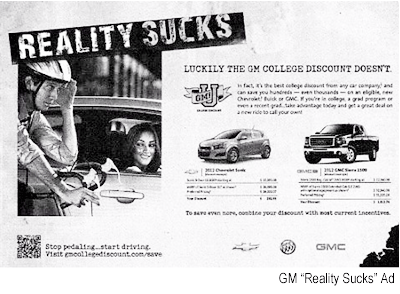 There is a powerful opportunity for brand managers to integrate corporate responsibility commitments into brand platforms to win consumer loyalty. General Motors and Zipcar both ran recent campaigns in universities to win over students. One car company shows they understand their target audience while the other shows a disconnect.
There is a powerful opportunity for brand managers to integrate corporate responsibility commitments into brand platforms to win consumer loyalty. General Motors and Zipcar both ran recent campaigns in universities to win over students. One car company shows they understand their target audience while the other shows a disconnect.
You may have heard about the “Reality Sucks” General Motors campaign that launched last month across various college campus newspapers in the US. The ad was promoting GM’s college discount, enabling students to buy Chevrolet, Buick, or GMC cars at a discount. The ad depicts a young woman in a car, smiling, or perhaps smirking, at an embarrassed-looking cyclist who pulled up alongside her, with the text underneath saying, “Stop pedalling … start driving.”

This ad caused an outrage amongst the cycling community as well as student groups across the web and social media platforms. The criticisms especially focused on the ad’s message conflicting with GM’s environmental commitments and corporate responsibility statement, which ironically states: “… we will actively participate in educating the public about environmental conservation”. It seems the brand manager who worked on the campaign had not been communicating with their Corporate Social Responsibility (CSR) department.
Furthermore, from a marketing point of view, it’s clear that the brand manager had not done his research to understand and properly connect to this offering’s target audience. University bicycle subculture is ubiquitous and is embedded into the college lifestyle. With prices at the pump rising, and with majority of students trying to pay their way through school, bicycles offer an inexpensive and fun method of transportation. Even the League of American Bicyclists points out “… obviously it’s been a while since GM execs and their creative teams set foot on campus.”
GM, to their credit, spent a long time responding to all the outrage messages they received via Facebook and Twitter and have apologized, changed the campaign and dropped the ad.
Brand Managers as Reputation Gatekeepers
Consumers expect brands to reflect socially and environmentally responsible business behavior (while also maintain quality and competitive prices). Discrepancies between a brand’s marketing message and a company’s corporate responsibility statement can tarnish a company’s hard to come by brand trust and consequently customer loyalty.
The 2011 GlobeScan Radar Report – a survey of consumer attitudes to company’s CSR performance – confirms that there is a large gap between consumer expectations and perception of industry CSR performance. GlobeScan suggests that the gap reflects silos within companies separating operational CSR and marketing and communications functions. Organizations that are integrating CSR effectively into brand platforms are winning consumer awareness.
In its Corporate Social Responsibility Guide for Business, International Institute for Sustainable Development points out that “the effect of a tarnished reputation often extends far beyond that one firm: entire sectors and, indeed, nations can suffer”. Firms frequently expend considerable time and money attempting to regain their reputation, with mixed results.
Brand managers are recognized as gate keepers for internal and external communications and messaging affecting their brands, but they are not spending enough time understanding how their brand fits into the broader corporate responsibility and sustainability commitments.
There is a powerful opportunity for brand managers to collaborate with operational sustainability colleagues to identify innovative ways of not only enhancing the product, but also differentiating, and telling a compelling brand story.
Social Media Shaping Brand’s Public Perception
According to a 2010 Nielson study, social network websites account for over 22% of all time spent on the Internet. These platforms are shaping the public perception of a brand. They can start vital communication campaigns that can either build or destroy a brand’s reputation.
As the GM example indicates, when a brand makes a claim that is contradictory to their corporate responsibility commitments, and also contradictory to their target market’s values, the trust is broken. The League of American Bicyclists expresses that sentiment: “If you are a student looking to add tens of thousands of dollars of long term debt, care little about the environment, and want to lump two tons of steel around campus while paying through the nose for insurance, gas, and parking…General Motors has got a perfect deal for you. Bonus: it’ll make you fat and unhealthy! All you have to do is give up that dorky bicycle that’s easy to use, practically free, gets you some exercise and is actually fun to ride.”
Effective CSR/Brand Integration Winning Consumer Awareness
Compare the GM campaign with a Zipcar campaign also targeting college students.

The brand manager for this campaign understands that it is a hassle for students to own a car on campus. This campaign also addresses financial barriers, and clearly connects Zipcar’s corporate responsibility commitments with the value proposition of this offer by stating that choosing to not own a car and drive Zipcars reduces demand for on-campus parking, alleviates congestion, and is a sustainable alternative transportation solution that reduces your carbon footprint.
Is it working? Zipcar’s membership in its North American market has doubled from 200K members in 2008 to 400K in 2010. With an impressive 30% membership growth 2011 third quarter, it now exceeds half million members in North America. And, the potential of much greater penetration levels increases, as the popularity of car sharing rises in North America.
I welcome your thoughts and feedback on this topic. Please join the conversation by adding your ideas to the comments section, or connect and continue the conversation on Twitter.

Great comparison – #greenmarketing Integrating Corporate Responsibility Into Brand: GM vs Zipcar http://t.co/gH9nvEhe
Integrating Corporate Responsibility Into Brand: GM vs Zipcar http://t.co/cC4u4kNP
Integrating Corporate Responsibility Into Brand: GM vs Zipcar http://t.co/eNxSuaHA
Good article – although I hate it when authors state professionals to be male without actually knowing i.e. brand manager in this case. Why does this happen???!!!!
Great comparison. A must read for all corporations.
I never thought of comparing these two companies in the manner that you have. It really puts how both companies work into perspective in a way that many people don’t realize.